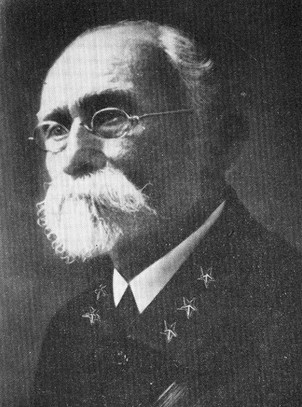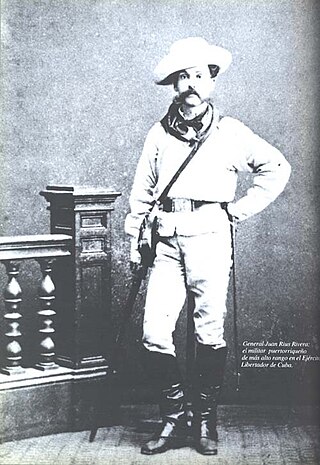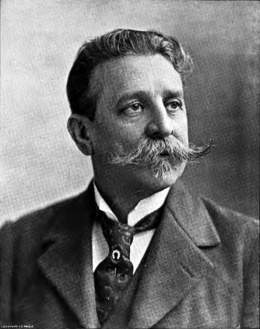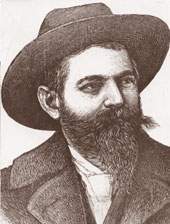Alfredo Rego | |
|---|---|
| Birth name | Alfredo Rego |
| Born | Cienfuegos, Captaincy General of Cuba, Spanish Empire |
| Allegiance | |
| Service/ | Cuban Army |
| Rank | General |
| Battles/wars | |
Alfredo Rego was a Cuban general and veteran of the Cuban War of Independence.
Alfredo Rego | |
|---|---|
| Birth name | Alfredo Rego |
| Born | Cienfuegos, Captaincy General of Cuba, Spanish Empire |
| Allegiance | |
| Service/ | Cuban Army |
| Rank | General |
| Battles/wars | |
Alfredo Rego was a Cuban general and veteran of the Cuban War of Independence.
Alfredo Rego was born in the Cienfuegos Province of Cuba.
In August 1895, he helped organize a local rebel force, the Brigade of Cienfuegos, in which José González Planas led the infantry and Rego led the cavalry. [1] The Cienfuegos Brigade had roughly 400 new soldiers incorporated in the Santa Clara Province by September. [2] Serving as the brigadier general of the Cienfuegos brigade, Rego engaged a force of 1500 Spaniards in combat in November 1895 with 800 fully armed cavalrymen. It was fought on the sugar plantation of Cantabria in Cienfuegos and was known as the Battle of Cantabria. [3] Twenty-eight weapons, a high quantity of ammunition, and sixteen Spaniards—two of them severely wounded—were captured by Rego's forces. After tending to the soldiers' wounds, he handed both over to a party dispatched by the Spanish commander. [4] Soon after, General Luis Manuel de Pando y Sánchez wrote to Rego, offering him $60,000 and the rank of brigadier general in the Spanish army in exchange for abandoning the Cuban cause. [5]
Rego was regarded as the best horseman in the Cuban army and had been promoted to general despite being severely wounded several times. [6]
A Cuban hospital was defended against Spanish forces, the Saboya battalion, in July 1897 by forces under General Alfredo Rego. 2,000 people engaged in combat on both sides, resulting in 44 Spanish deaths and 60 injuries, as well as 24 Cuban deaths and 50 injuries. [6] Following the battle, Rego treated the wounded Spaniards in the hospital they intended to raid. [7]
General Alfredo Rego and Captain Rosendo Collazo led a combined force of 130 rural guards and volunteers in 1906 against 400 rebels in Havana. [8] [9]

The Cuban Revolutionary Armed Forces are the military forces of Cuba. They include Revolutionary Army, Revolutionary Navy, Revolutionary Air and Air Defense Force, and other paramilitary bodies including the Territorial Troops Militia, Youth Labor Army, and the Defense and Production Brigades, plus the Civil Defense Organization and the National Reserves Institution. All these groups are subordinated to the Ministry of the Revolutionary Armed Forces.

The Ten Years' War, also known as the Great War and the War of '68, was part of Cuba's fight for independence from Spain. The uprising was led by Cuban-born planters and other wealthy natives. On 10 October 1868, sugar mill owner Carlos Manuel de Céspedes and his followers proclaimed independence, beginning the conflict. This was the first of three liberation wars that Cuba fought against Spain, the other two being the Little War (1879–1880) and the Cuban War of Independence (1895–1898). The final three months of the last conflict escalated with United States involvement, leading to the Spanish–American War.

Lt. General José Antonio de la Caridad Maceo y Grajales was a Cuban general and second-in-command of the Cuban Army of Independence.

Máximo Gómez y Báez was a Cuban-Dominican Generalissimo in Cuba's War of Independence (1895–1898). He was known for his controversial scorched-earth policy, which entailed dynamiting passenger trains and torching the Spanish loyalists' property and sugar plantations—including many owned by Americans. He greatly increased the efficacy of the attacks by torturing and killing not only Spanish soldiers, but also Spanish sympathizers and especially Cubans loyal to Spain. By the time the Spanish–American War broke out in April 1898, the rebellion was virtually defeated in most of Western Cuba, with only a few operating pockets in the center and the east. He refused to join forces with the Spanish in fighting off the United States, and he retired to the Quinta de los Molinos, a luxury villa outside of Havana after the war's end formerly used by captains generals as summer residence.

General Juan Rius Rivera, was the soldier and revolutionary leader from Puerto Rico to have reached the highest military rank in the Cuban Liberation Army and to hold Cuban ministerial offices after independence. In his later year, he also became a successful businessperson in Honduras.

Cruces is a municipality and town in Cienfuegos Province, Cuba. It is the home of the Mal Tiempo National Park which commemorates a battle in the 1895 War of Independence.

The Cuban War of Independence, also known in Cuba as The Necessary War, fought from 1895 to 1898, was the last of three liberation wars that Cuba fought against Spain, the other two being the Ten Years' War (1868–1878) and the Little War (1879–1880). The final three months of the conflict escalated to become the Spanish–American War, with United States forces being deployed in Cuba, Puerto Rico, and the Philippine Islands against Spain. Historians disagree as to the extent that United States officials were motivated to intervene for humanitarian reasons but agree that yellow journalism exaggerated atrocities attributed to Spanish forces against Cuban civilians.
The military history of Cuba is an aspect of the history of Cuba that spans several hundred years and encompasses the armed actions of Spanish Cuba while it was part of the Spanish Empire and the succeeding Cuban republics.

The Cuban Revolutionary Air and Air Defense Force commonly abbreviated to DAAFAR in both Spanish and English, is the air force of Cuba.

Pedro Betancourt Dávalos (1858–1933) was a medical doctor, major general, diplomat, Secretary of Agriculture, politician, and Cuban revolutionary in the Cuban War of Independence.
The Invasion from East to West took place on the island of Cuba, and began on October 22, 1895, in Mangos de Baraguá, in the former province of Oriente. It was organized and directed by Antonio Maceo Grajales and Máximo Gómez. The Liberation Army, guided by the firmness of taking the fight against Spanish colonialism to all corners of Cuba, starred in one of the most relevant events in Cuban history. In the midst of the "Cuban War of Independence", inspired by José Martí, that campaign responded to the old desire of the insurgent generals Maceo and Gómez. These launched the strategy of limiting the liberation struggle to the eastern territory of the Island, but rather extending it throughout the entire Cuban territory to force Spain to fight simultaneously in the six provinces that the country had at that time, in order to weaken it on all fronts.

Julio Sanguily Garritte (1845–1906) was a Cuban independence activist and insurgent who took prominent roles in the rebel army during the Ten Years' War (1868–1878) and the Cuban War of Independence(1895–1898).

The Battle of Montecristi was fought on May 15, 1864 in the Dominican Republic, during the Dominican Restoration War (1863–65) between Dominican forces and Spain. A Spanish force of 6,000 troops supported by 13 cannons, commanded by General José de la Gándara, appointed captain-general of Santo Domingo since March, confronted the Dominican insurgents commanded by Benito Monción. The latter, who took refuge in the town of Monte Cristi, suffered a defeat and were forced to retreat, but not without inflicting disproportionate casualties on their opponents. The future Spanish general Fernando Primo de Rivera y Sobremonte was wounded during the fighting.
The Battle of Calimete was a battle of the Cuban War of Independence on December 29, 1895, which was led by Cuban independence activists Máximo Gómez, Antonio Maceo and later on, Serafín Sánchez.

The La Reforma Campaign was a campaign of the Cuban War of Independence which was waged for 16 months with the Cuban forces under the command of Máximo Gómez against the Spanish forces under the command of Valeriano Weyler. Despite the Spanish outnumbering the Cuban forces by 40,000 to 600, Gómez's guerrilla warfare tactics as well as the weather caused over 40 Spanish soldiers to die each day throughout the campaign. His approach was to divide his forces into tiny guerrilla groups and fight alone with his General Staff while continuously moving.

Francisco de Borja Canella y Secades was a Spanish Divisional General during the 19th century. He was famously known as the "Hero of Sao del Indio" for his service during the Battle of Sao del Indio of the Cuban War of Independence and earned the Laureate Cross of San Fernando for his service there.

The Cuban Liberation Army, colloquially known as the Mambí Army was an insurgent army which was formed in the last third of the 19th century and fought for independence from Spain and the abolition of slavery. It first saw combat in the Ten Years' War (1868–1878) under the command of Carlos Manuel de Céspedes, Ignacio Agramonte, and Carlos Roloff. The independentists were decentralized and operated within their own regions autonomously of each other, until the Assembly of Guáimaro established the Republic-in-Arms of Cuba and the Liberation Army's command structure. After the Pact of Zanjón, a brief uprising called the Little War saw Majors-General Calixto García and Antonio Maceo lead the Army of Liberation in another attempt at independence and the abolition of slavery, though unsuccessfully. Finally, during the War of Independence, the Liberation Army was once again organized to fight against the Spanish colonial government. The Liberation Army would reach its highest count of active members in the Spanish-American War, when an imminent Cuban-American victory caused hitherto anti-independence elites to join the Liberation Army. These recruits were nicknamed "Sunflowers" because they "point to where the sun is shining".
Rosendo Collazo was a Cuban senator, army colonel, and veteran of the Cuban War of Independence.

Enrique Collazo Tejada was a Cuban writer, army general, and distinguished veteran of the Ten Years' War and War of Independence.
José de Valera was a high-ranking Spanish military figure who distinguished himself in Cuba's Ten Years' War.